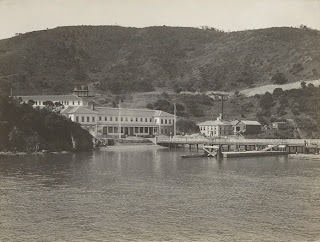 |
| Fort Mcdowell |
Tuesday, May 31, 2011
Dentention and Discharge Camps
 |
| Fort Mcdowell Battery Emplacement Battery Ledyard housed two 5" guns with Barbette carriages http://usforting.com/2009/09/04/fort-mcdowell-on-angel-island/ |
Access to Angel Island
Monday, May 30, 2011
Flames
-Patrick Li
http://www.marinij.com/marinnews/ci_10713017?source=pkg
The Chinese Exclusion Act
-Patrick Li
http://www.parks.ca.gov/default.asp?page_id=468
The Chinese People
-Patrick Li
http://angelisland.org/
Current Uses
-Andrew Yu
Sources:
http://angelisland.org/history/united-states-immigration-station-usis/tours/
http://www.nps.gov/history/nr/travel/ca/
Fort McDowell
-Andrew Yu
Sources:
http://www.english.illinois.edu/maps/poets/a_f/angel/angel.htm
http://www.onscenicroutes.com/angelislandmain.html
General Information and Stats on Angel Island
Coordinates: 37.86*N 122.43
Area: 1.2 sq mi (3.1 km2)
Highest elevation: 788 ft (240.2 m)
Highest point: Mount Caroline Livermore
Country: United States
State: California
County: Marin County, San Francisco County
Population: 57
Density 18.35 /km2 (47.53 /sq mi)
Designated as a National Historic Landmark
Named Angel Island because Angels were rumored to flock the island in the past
Previously named Fort McDowell
-Andrew Yu
Photo: Angel Island Immigration Station
FACTS
- largest island in the San Francisco Bay
- nicknamed as the “Ellis Island of the West”
- Area: 1.2 square miles
- Highest point: Mt. Caroline Livermore
- Population: 57
- earliest known inhabitants: Miwok Indians
- explored by the Spanish in 1775
- came under US control in 1851
- US army base from 1863-1946
- radar missile site from 1955-1962
- immigration center from 1910-1940
- confined military prisoners during World War II
Photo: Angel Island as an Immigration Center
 A Chinese immigrant is inhumanely inspected by an American official.
A Chinese immigrant is inhumanely inspected by an American official.History
The Angel Island Immigration Station was opened in 1910 and lasted until 1940, and was the main entry point for immigrants arriving from the Pacific. More than one million people were processed at the station. Many immigrants, specifically the Chinese, were not allowed or welcomed into the country. This was due to the Chinese Exclusion Laws, which was first passed in 1882, and updated until 1943 to keep Chinese and other Asian ethnic groups from entering the United States. The arrival of World War II brought an end to the Chinese Exclusion Laws after China allied with the United States. In 1954, the Angel Island Immigration Station was turned over to the state of California. Because of the Cold War, a radar and missile site was built on the island from 1955 to 1962. In 2009, Angel Island was renovated and reopened as a state park.
Sources:
http://www.aiisf.org/history
http://angelisland.org/history/

